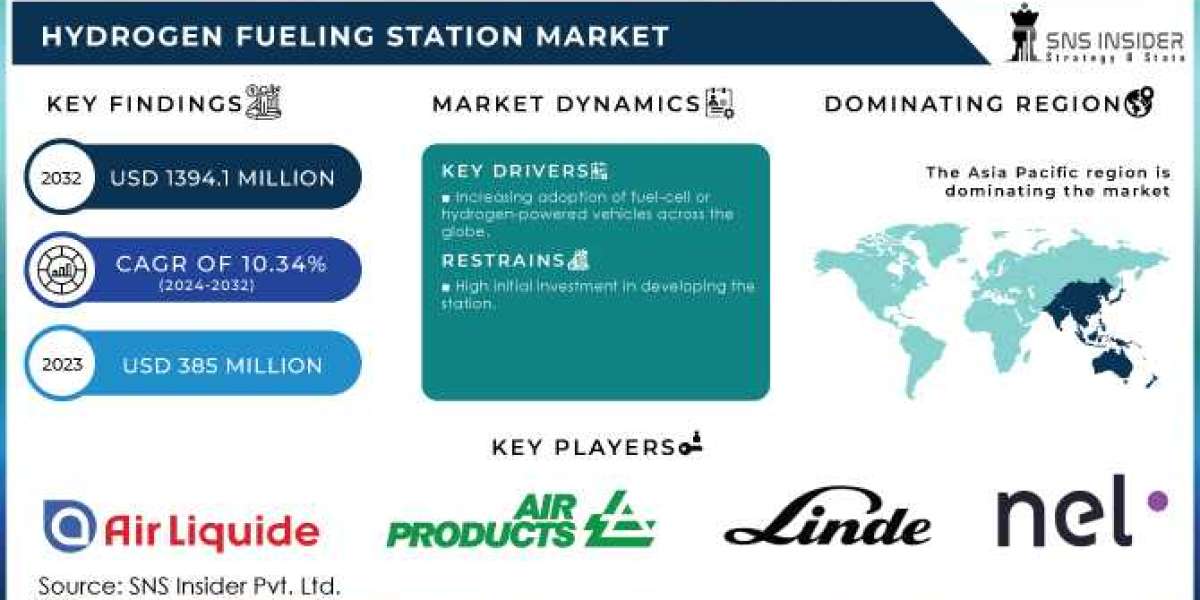The Hydrogen Fueling Station Market size was valued at USD 385 million in 2023 and is expected to grow to USD 1394.1 million by 2032 and grow at a CAGR of 15.37% over the forecast period of 2024–2032.
As countries focus on reducing carbon emissions and enhancing energy security, hydrogen has emerged as a key solution to the challenges of decarbonizing transportation, industrial operations, and energy generation. The growing number of hydrogen-powered vehicles, including cars, buses, trucks, and even trains, is driving demand for a widespread and reliable network of hydrogen fueling stations.
Market Overview
Hydrogen fueling stations are vital for the growth of the hydrogen economy, providing the necessary infrastructure for refueling fuel cell electric vehicles (FCEVs) that run on hydrogen. These stations typically store hydrogen in either liquid or gaseous form and dispense it to vehicles at high pressure. As governments and private players invest in green hydrogen production and infrastructure, the hydrogen fueling station market is expected to expand substantially.
Key Market Drivers
- Rising Adoption of Hydrogen-Powered Vehicles: The increasing adoption of FCEVs in the transportation sector is a major driver of the hydrogen fueling station market. FCEVs offer a clean alternative to traditional vehicles, producing only water vapor as a byproduct, making them ideal for reducing emissions in public and commercial transportation.
- Government Initiatives and Funding: Many countries, particularly in Europe, North America, and Asia-Pacific, are introducing policies and funding programs to support the development of hydrogen infrastructure. Government support is critical to building hydrogen fueling stations, especially in early stages, to reduce barriers to FCEV adoption.
- Technological Advancements in Hydrogen Storage and Dispensing: Ongoing innovations in hydrogen storage and dispensing technologies are improving the efficiency and safety of hydrogen fueling stations. New technologies are enabling faster refueling times, higher storage capacities, and cost-effective operations, making hydrogen a more viable fuel option.
- Decarbonization of Heavy-Duty Transportation: The growing focus on reducing emissions in heavy-duty transportation, including buses, trucks, and trains, is boosting the demand for hydrogen fueling stations. Hydrogen fuel cells offer a high energy density solution, particularly suited for long-haul transportation, where batteries may not be as efficient.
- Collaborative Efforts Across Industries: Major automakers, energy companies, and technology providers are collaborating to accelerate the deployment of hydrogen fueling stations. Partnerships between industry players are helping to build the necessary infrastructure to support hydrogen-powered vehicles and create an integrated hydrogen economy.
Market Segmentation
The Hydrogen Fueling Station Market is segmented based on station type, vehicle type, and region, providing a detailed analysis of the market’s potential.
By Station Type
- Retail Hydrogen Fueling Stations: These stations serve the general public and are often located in urban areas or along highways to support passenger cars and light commercial vehicles.
- Commercial Hydrogen Fueling Stations: Designed for fleet operations, these stations cater to heavy-duty vehicles, including buses, trucks, and trains, and are often built near transportation hubs and industrial sites.
- Mobile Hydrogen Fueling Stations: Mobile or portable hydrogen stations are gaining popularity in areas where permanent infrastructure is not yet established. These stations provide flexible and temporary refueling solutions for events, pilot programs, and remote locations.
- Others: Includes hydrogen production facilities with integrated fueling stations, as well as experimental stations that use emerging hydrogen storage and dispensing technologies.
By Vehicle Type
- Passenger Cars: The adoption of hydrogen-powered passenger vehicles is growing, especially in countries like Japan, South Korea, and parts of Europe, where governments are offering incentives and building hydrogen infrastructure.
- Buses and Trucks: The decarbonization of public transportation fleets and heavy-duty vehicles is a key growth area for hydrogen fueling stations. Hydrogen-powered buses and trucks offer long-range capabilities and fast refueling, making them suitable for large-scale operations.
- Trains and Other Vehicles: Hydrogen trains, particularly in Europe and Asia, are emerging as a low-emission alternative for rail transportation. Other vehicles, such as forklifts, drones, and maritime vessels, are also increasingly adopting hydrogen fuel cells.
Regional Analysis
- North America: The North American market is expected to see substantial growth, driven by investments in hydrogen infrastructure in the United States and Canada. Several initiatives, including the deployment of hydrogen fueling stations along major transportation corridors, are already underway.
- Europe: Europe is leading the global hydrogen transition, with countries such as Germany, France, the Netherlands, and the UK focusing on building extensive hydrogen fueling infrastructure. The European Union’s commitment to becoming carbon neutral by 2050 is a key factor driving the expansion of hydrogen fueling stations across the continent.
- Asia-Pacific: The Asia-Pacific region is a major hub for hydrogen fueling station development, with countries like Japan, South Korea, and China at the forefront. These nations are heavily investing in hydrogen technology, particularly in the transportation sector, to meet their ambitious clean energy targets.
- Middle East Africa: The Middle East is beginning to explore hydrogen as part of its clean energy strategy, with investments in hydrogen production and infrastructure, particularly in the United Arab Emirates and Saudi Arabia. Africa is also emerging as a potential market, with opportunities for green hydrogen production to power local economies.
- Latin America: Latin America is gradually adopting hydrogen technology, with Brazil and Chile investing in renewable energy and hydrogen infrastructure to support their decarbonization goals.
Current Market Trends
- Hydrogen Corridors: The development of hydrogen corridors along major highways and transportation routes is a key trend in the market. These corridors are designed to support long-distance travel for hydrogen-powered trucks and passenger vehicles by ensuring an extensive network of refueling stations.
- Green Hydrogen Initiatives: Green hydrogen, produced using renewable energy sources such as solar and wind, is gaining momentum as countries and companies prioritize sustainable hydrogen production. Green hydrogen fueling stations are being integrated into renewable energy projects to promote the use of clean hydrogen.
- Expansion of Public and Private Partnerships: Collaborations between governments, automakers, and energy providers are critical to accelerating the deployment of hydrogen fueling stations. These partnerships are enabling large-scale hydrogen infrastructure projects that can meet growing demand.
- Focus on Heavy-Duty Applications: While passenger cars are a key market, heavy-duty vehicles such as buses, trucks, and trains are becoming a major focus for hydrogen fueling stations, particularly in regions with ambitious emission reduction targets.
Read Complete Report Details of Hydrogen fueling stations Market 2024–2032@ https://www.snsinsider.com/reports/hydrogen-fueling-station-market-2720
About Us:
SNS Insider is a global leader in market research and consulting, shaping the future of the industry. Our mission is to empower clients with the insights they need to thrive in dynamic environments. Utilizing advanced methodologies such as surveys, video interviews, and focus groups, we provide up-to-date, accurate market intelligence and consumer insights, ensuring you make confident, informed decisions.
Contact Us:
Akash Anand — Head of Business Development Strategy
info@snsinsider.com
Phone: +1–415–230–0044 (US) | +91–7798602273 (IND)














